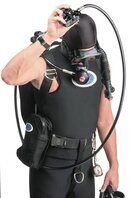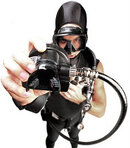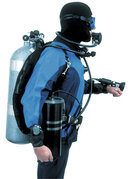Angle Adapters/Swivels - 40in prim w/ angle adapter or swivel, 22-24in bungee backup
With this configuration you exchange the long hose for a 40in hose on an angle adapter or swivel. Very similar to the long hose configuration with the exception that you get rid of the major benefits that a long hose provides, and that is spacing during OOA shares. You're still able to perform a face-to-face horizontal safety stop with an OOA diver just as if you're using a long hose, however you won't be able to get very much distance from them.
40in hoses are easier to manage though and they're compatible with all types of BC's. Adding the angle adapter or swivel does add more points of failure, that is not to say they increase your likely hood of a failure.
Angle adapters use two standard hose connections to allow 2 points of 360 degree rotation between your second stage and hose. Swivels use two standard hose connection and a swivel to allow 3 points of 360 degrees rotation between your second stage and hose.
The swivel had a bad track record in which one such unit separated completely at the swivel point resulting in a massive loss of air from the diver's regulator hose. This was only 1 incident back in 2007 and only by 1 manufacturer as far as I know. A recall was made and today many swivels are sold and in use. I would recommend using a 90 degree Angle Adapter, since you only need 2 points of rotation, a third gets to be excessive.
To route your hose, the primary goes under your right arm and then into your mouth. The angle adapter allows for the hose to sit nicely along your right side. To donate, grab the hose under the angle adapter, pull the primary out of your mouth, spin the primary second stage around with your index finger, tuck your right elbow under the loop of your hose, and then outstretch your arm to hand it off.
Pros -
- OOA Donor give up a known working reg
- Backup is always slug under your chin, it will never move or drag if you've ziptied the bungee to it
Cons -
- Angle adapter/swivel may clash or hook onto your bungee backup; a turn of the head unhooks it
- New points of failure added; this does NOT mean it it likely to fail
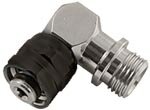
90 degree Angle Adapter
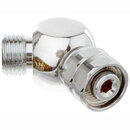
20 degree Angle Adapter
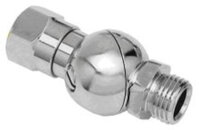
Swivel
Air2's & Integrated Octos - 26in-9ft primary, Integrated Octo Inflator
Integrated Octo Inflator or more popularly known as an Air 2 (after Scubapro's made-popular model) allows you to get rid of your octo hose and combine your inflator with a backup regulator. When donating air, the donor give up the primary and takes the Air 2.
With Air 2's regulator setups are 1 hose cleaner and BC's can now inflate faster. The Air 2 uses a different hose connection from the standard inflator. The connection is usually bigger and allows for more air to flow, meaning you can breath easy from the Air 2 and your BC can inflate faster. I would recommend getting a 40in primary hose at the very least. With an Air 2, dumping air on ascent with an OOA diver glued to you is very tricky.
To dump air on ascent there are 3 methods.
1) Remove Air 2 from mouth and dump.
Major problem with this is you lose your air source. The Pros is you have great control over how much air you dump.
2) Use alternative dump ports on BC
With this method you can dump a lot of air quickly, which can be both a pro and a con. One problem with this is you can lose some minute control over how much air you dump. A Pro is you get to keep an air source in your mouth.
3) Dump w/ Air 2
This method is tricky to use at times, but it's semi-familiar to the diver. To dump, you look up and depress the deflate button on your Air 2 while exhaling. If your bladder is over inflated, air should dump through the exhaust tee of your Air 2. Problems with this method are you have to be exhaling or risk breathing bladder air, it's a slow dump of air, and you have to be very vertical in the water column for this to work.
Pros -
- 1 less hose to clutter your regulator setup
- Air 2 is always in the same place
Cons -
- Air 2's are heavy units compared to standard inflators
- They can drag in the sand and get mucked up
- Because they can drag they could also clog or get stuck on inflate when you use it
- Some BC hoses are stiff and therefore push the Air 2 out of your mouth when you deploy it
___________________
I'm sure there are plenty of other pros and cons for these reg configurations. Feel free to ask around about them. Everyone has their own opinion.




